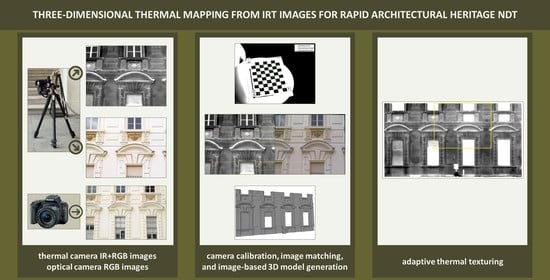Three-Dimensional Thermal Mapping from IRT Images for Rapid Architectural Heritage NDT
Abstract
1. Introduction and Background
1.1. Related Work
1.2. Research Aims and Paper Structure
2. Materials and Methods
2.1. Materials
2.2. Image Acquisition
2.3. Camera Calibration and Image Registration
2.4. Image Pose Computation and Model Generation
2.5. Thermal Texture Mapping
3. Experimental Results
3.1. Data Collection
3.2. Thermographic 3D Mapping Results
4. Validation and Discussion
4.1. Evaluation and Comparison with Other Methods
4.2. Application with a Medium-Resolution Thermal Camera
4.3. Application for Complex Geometries
4.4. Extraction of Temperature Measurements
5. Conclusions
Author Contributions
Funding
Conflicts of Interest
References
- Maldague, X. Theory and Practice of Infrared Technology for Non-Destructive Testing. In Wiley Series in Microwave and Optical Engineering; Wiley: New York, NY, USA, 2001; ISBN 978-0-471-18190-3. [Google Scholar]
- Avdelidis, N.P.; Moropoulou, A. Emissivity considerations in building thermography. Energy Build. 2003, 35, 663–667. [Google Scholar] [CrossRef]
- Grinzato, E.; Bison, P.G.; Marinetti, S. Monitoring of ancient buildings by the thermal method. J. Cult. Herit. 2002, 3, 21–29. [Google Scholar] [CrossRef]
- Kylili, A.; Fokaides, P.A.; Christou, P.; Kalogirou, S.A. Infrared thermography (IRT) applications for building diagnostics: A review. Appl. Energy 2014, 134, 531–549. [Google Scholar] [CrossRef]
- Brooke, C. Thermal Imaging for the Archaeological Investigation of Historic Buildings. Remote Sens. 2018, 10, 1401. [Google Scholar] [CrossRef]
- Moropoulou, A.; Labropoulos, K.C.; Delegou, E.T.; Karoglou, M.; Bakolas, A. Non-destructive techniques as a tool for the protection of built cultural heritage. Constr. Build. Mater. 2013, 48, 1222–1239. [Google Scholar] [CrossRef]
- Lerma, C.; Mas, Á.; Gil, E.; Vercher, J.; Torner, M.E. Quantitative Analysis Procedure for Building Materials in Historic Buildings by Applying Infrared Thermography. Russ. J. Nondestruct. Test. 2018, 54, 601–609. [Google Scholar] [CrossRef]
- Delegou, E.T.; Mourgi, G.; Tsilimantou, E.; Ioannidis, C.; Moropoulou, A. A Multidisciplinary Approach for Historic Buildings Diagnosis: The Case Study of the Kaisariani Monastery. Heritage 2019, 2, 1211–1232. [Google Scholar] [CrossRef]
- Volinia, M. Integration of Qualitative and Quantitative Infrared Surveys to Study the Plaster Conditions of Valentino Castle. In SPIE Proceedings Volume 4020, Thermosense XXII, Proceedings of the AeroSense 2000, Orlando, FL, USA, 25–27 April 2000; Dinwiddie, R.B., LeMieux, D.H., Eds.; SPIE: Bellingham, WA, USA, 2000; pp. 324–334. [Google Scholar]
- de Freitas, S.S.; de Freitas, V.P.; Barreira, E. Detection of façade plaster detachments using infrared thermography—A non-destructive technique. Constr. Build. Mater. 2014, 70, 80–87. [Google Scholar] [CrossRef]
- Tavukçuoğlu, A.; Akevren, S.; Grinzato, E. In situ examination of structural cracks at historic masonry structures by quantitative infrared thermography and ultrasonic testing. J. Mod. Opt. 2010, 57, 1779–1789. [Google Scholar] [CrossRef]
- Zhang, R.; Li, H.; Duan, K.; You, S.; Liu, K.; Wang, F.; Hu, Y. Automatic Detection of Earthquake-Damaged Buildings by Integrating UAV Oblique Photography and Infrared Thermal Imaging. Remote Sens. 2020, 12, 2621. [Google Scholar] [CrossRef]
- Danese, M.; Demšar, U.; Masini, N.; Charlton, M. Investigating material decay of historic buildings using visual analytics with multi-temporal infrared thermographic data: Investigating material decay of historic buildings. Archaeometry 2009, 52, 482–501. [Google Scholar] [CrossRef]
- İnce, İ.; Bozdağ, A.; Tosunlar, M.B.; Hatır, M.E.; Korkanç, M. Determination of deterioration of the main facade of the Ferit Paşa Cistern by non-destructive techniques (Konya, Turkey). Environ. Earth Sci. 2018, 77, 420. [Google Scholar] [CrossRef]
- Moropoulou, A.; Avdelidis, N.P.; Theoulakis, P.; Koui, M. Thermography as an evaluation tool for studying the movement of water through various porous materials: Capillary rise and evaporation. In Proceedings of the SPIE Aerospace/Defense Sensing, Simulation, and Controls, Orlando, FL, USA, 16–20 April 2001; Rozlosnik, A.E., Dinwiddie, R.B., Eds.; International Society for Optics and Photonics: Bellingham, WA, USA; pp. 229–235.
- Lerma, J.L.; Cabrelles, M.; Portalés, C. Multitemporal thermal analysis to detect moisture on a building façade. Constr. Build. Mater. 2011, 25, 2190–2197. [Google Scholar] [CrossRef]
- Spodek, J.; Rosina, E. Application of Infrared Thermography to Historic Building Investigation. J. Archit. Conserv. 2009, 15, 65–81. [Google Scholar] [CrossRef]
- Ibarra-Castanedo, C.; Sfarra, S.; Klein, M.; Maldague, X. Solar loading thermography: Time-lapsed thermographic survey and advanced thermographic signal processing for the inspection of civil engineering and cultural heritage structures. Infrared Phys. Technol. 2017, 82, 56–74. [Google Scholar] [CrossRef]
- Moropoulou, A.; Avdelidis, N.P.; Koui, M.; Delegou, E.T.; Tsiourva, T. Infrared thermographic assessment of materials and techniques for the protection of cultural heritage. In Proceedings of the Multispectral Image Processing and Pattern Recognition, Wuhan, China, 22–24 October 2001; Tong, Q., Zhu, Y., Zhu, Z., Eds.; International Society for Optics and Photonics: Bellingham, WA, USA; p. 313.
- Adamopoulos, E.; Tsilimantou, E.; Keramidas, V.; Apostolopoulou, M.; Karoglou, M.; Tapinaki, S.; Ioannidis, C.; Georgopoulos, A.; Moropoulou, A. Multi-Sensor Documentation of Metric and Qualitative Information of Historic Stone Structures. ISPRS Ann. Photogramm. Remote Sens. Spatial Inf. Sci. 2017, IV-2/W2, 1–8. [Google Scholar] [CrossRef]
- Biscarini, C.; Catapano, I.; Cavalagli, N.; Ludeno, G.; Pepe, F.A.; Ubertini, F. UAV photogrammetry, infrared thermography and GPR for enhancing structural and material degradation evaluation of the Roman masonry bridge of Ponte Lucano in Italy. NDT E Int. 2020, 115, 102287. [Google Scholar] [CrossRef]
- Etxepare, L.; Leon, I.; Sagarna, M.; Lizundia, I.; Uranga, E.J. Advanced Intervention Protocol in the Energy Rehabilitation of Heritage Buildings: A Miñones Barracks Case Study. Sustainability 2020, 12, 6270. [Google Scholar] [CrossRef]
- Gomes-Heras, M.; López-González, L.; García-Morales, S.; Fort, R.; Álvarez de Buergo, M. Integrating Non-Destructive Techniques with Photogrammetry 3D Models for the Development of Geographic Information Systems in Heritage Structures. In Science, Technology and Cultural Heritage, Proceedings of the Second International Congress on Science and Technology for the Conservation of Cultural Heritage, Sevilla, Spain, 24–27 June 2014; Rogerio-Candelera, M.A., Ed.; Taylor & Francis Group: London, UK, 2014; pp. 429–434. ISBN 978-1-138-02744-2. [Google Scholar]
- Soile, S.; Tsilimantou, E.; Keramidas, V.; Karoglou, M.; Bourexis, F.; Adamopoulos, E.; Delegou, T.E.; Lampropoulos, K.; Ioannidis, C.; Moropoulou, A.; et al. Multidisciplinary Documentation Using Non-destructive Testing Techniques for the Diagnostic Study of an Ancient Temple. In Nondestructive Evaluation and Monitoring Technologies, Documentation, Diagnosis and Preservation of Cultural Heritage; Osman, A., Moropoulou, A., Eds.; Springer Proceedings in Materials; Springer International Publishing: Cham, Switzerland, 2019; pp. 17–36. ISBN 978-3-030-25762-0. [Google Scholar]
- Spanò, A.; Volinia, M.; Girotto, M. Spatial Data and Temperature: Relationship to Deepen. Integrated Methods for Advanced Architectural Diagnosis and Metric Documentation. In Proceedings of the art ‘05. Eightth Internation Conference on Non’Destructive Investigations and Microanalysis for the Diagnostics and Conservation of the Cultural and Environmental Heritage, Lecce, Italy, 15–19 May 2005; Marabelli, M., Parisi, C., Buzzanca, G., Paradisi, A., Eds.; Italian Society of Non-Destructive Testing Monitoring Diagnostics AIPnD: Brescia, Italy, 2005. [Google Scholar]
- Costanzo, A.; Minasi, M.; Casula, G.; Musacchio, M.; Buongiorno, M. Combined Use of Terrestrial Laser Scanning and IR Thermography Applied to a Historical Building. Sensors 2015, 15, 194–213. [Google Scholar] [CrossRef] [PubMed]
- Zalama, E.; Gómez-García-Bermejo, J.; Llamas, J.; Medina, R. An Effective Texture Mapping Approach for 3D Models Obtained from Laser Scanner Data to Building Documentation: An effective texture mapping approach. Comput. Aided Civ. Infrastruct. Eng. 2011, 26, 381–392. [Google Scholar] [CrossRef]
- Mileto, C.; Vegas, F.; Lerma, J.L. Multidisciplinary Studies, Crossreading and Transversal Use of Thermography: The Castle of Monzón (Huesca) as a case study. In Proceedings of the Modern Age Fortifications of the Mediterranean Coast—Defensive architecture of the Mediterranean (FORTMED2015), 15–17 October 2015; Editorial Universitat Politècnica de València, Ed.; Editorial Universitat Politècnica de València: Valencia, Spain, 2015. [Google Scholar]
- Lagüela, S.; Díaz-Vilariño, L.; Martínez, J.; Armesto, J. Automatic thermographic and RGB texture of as-built BIM for energy rehabilitation purposes. Autom. Constr. 2013, 31, 230–240. [Google Scholar] [CrossRef]
- González-Aguilera, D.; Rodriguez-Gonzalvez, P.; Armesto, J.; Lagüela, S. Novel approach to 3D thermography and energy efficiency evaluation. Energy Build. 2012, 54, 436–443. [Google Scholar] [CrossRef]
- Alba, M.I.; Barazzetti, L.; Scaioni, M.; Rosina, E.; Previtali, M. Mapping Infrared Data on Terrestrial Laser Scanning 3D Models of Buildings. Remote Sens. 2011, 3, 1847–1870. [Google Scholar] [CrossRef]
- Borrmann, D.; Elseberg, J.; Nüchter, A. Thermal 3D Mapping of Building Façades. In Intelligent Autonomous Systems 12; Advances in Intelligent Systems and Computing; Sukhan, L., Hyungsuck, C., Kwang-Joon, Y., Jangmyung, L., Eds.; Springer: Berlin/Heidelberg, Germany, 2013; Volume 193, pp. 173–182. ISBN 978-3-642-33926-4. [Google Scholar]
- Merchán, P.; Merchán, M.J.; Salamanca, S.; Adán, A. Application of Multisensory Technology for Resolution of Problems in the Field of Research and Preservation of Cultural Heritage. In Advances in Digital Cultural Heritage; Lecture Notes in Computer Science; Ioannides, M., Martins, J., Žarnić, R., Lim, V., Eds.; Springer International Publishing: Cham, Switzerland, 2018; Volume 10754, pp. 32–47. ISBN 978-3-319-75788-9. [Google Scholar]
- Yang, M.-D.; Su, T.-C.; Lin, H.-Y. Fusion of Infrared Thermal Image and Visible Image for 3D Thermal Model Reconstruction Using Smartphone Sensors. Sensors 2018, 18, 2003. [Google Scholar] [CrossRef]
- Coret, L.; Briottet, X.; Kerr, Y.H.; Chehbouni, A. Simulation Study of View Angle Effects on Thermal Infrared Measurements Over Heterogeneous Surfaces. IEEE Trans. Geosci. Remote Sens. 2004, 42, 664–672. [Google Scholar] [CrossRef]
- González-Aguilera, D.; Lagüela, S.; Rodríguez-Gonzálvez, P.; Hernández-López, D. Image-based thermographic modeling for assessing energy efficiency of buildings façades. Energy Build. 2013, 65, 29–36. [Google Scholar] [CrossRef]
- Dlesk, A.; Vach, K.; Holubec, P. Usage of Photogrammetric Processing of Thermal Images for Civil Engineers. Int. Arch. Photogramm. Remote Sens. Spat. Inf. Sci. 2018, XLII–5, 99–103. [Google Scholar] [CrossRef]
- Macher, H.; Boudhaim, M.; Grussenmeyer, P.; Siroux, M.; Landes, T. Comaination of thermal and Geometric Information for BIM enrichment. Int. Arch. Photogramm. Remote Sens. Spat. Inf. Sci. 2019, XLII-2/W15, 719–725. [Google Scholar] [CrossRef]
- Previtali, M.; Barazzetti, L.; Redaelli, V.; Scaioni, M.; Rosina, E. Rigorous procedure for mapping thermal infrared images on three-dimensional models of building façades. J. Appl. Remote Sens. 2013, 7, 073503. [Google Scholar] [CrossRef][Green Version]
- Hoegner, L.; Stilla, U. Mobile thermal mapping for matching of infrared images with 3D building models and 3D point clouds. Quant. InfraRed Thermogr. J. 2018, 15, 252–270. [Google Scholar] [CrossRef]
- Dino, I.G.; Sari, A.E.; Iseri, O.K.; Akin, S.; Kalfaoglu, E.; Erdogan, B.; Kalkan, S.; Alatan, A.A. Image-based construction of building energy models using computer vision. Autom. Constr. 2020, 116, 103231. [Google Scholar] [CrossRef]
- Lin, D.; Jarzabek-Rychard, M.; Tong, X.; Maas, H.-G. Fusion of thermal imagery with point clouds for building façade thermal attribute mapping. ISPRS J. Photogramm. Remote Sens. 2019, 151, 162–175. [Google Scholar] [CrossRef]
- Heikkila, J.; Silven, O. A Four-Step Camera Calibration Procedure with Implicit Image Correction. In Proceedings of the IEEE Computer Society Conference on Computer Vision and Pattern Recognition, San Juan, PR, USA, 17–19 June 1997; pp. 1106–1112. [Google Scholar]
- Zhang, Z. A flexible new technique for camera calibration. IEEE Trans. Pattern Anal. Mach. Intell. 2000, 22, 1330–1334. [Google Scholar] [CrossRef]
- Chiabrando, F.; Donadio, E.; Rinaudo, F. SfM for Orthophoto to Generation: A Winning Approach for Cultural Heritage Knowledge. Int. Arch. Photogramm. Remote Sens. Spat. Inf. Sci. 2015, XL-5/W7, 91–98. [Google Scholar] [CrossRef]
- Peña-Villasenín, S.; Gil-Docampo, M.; Ortiz-Sanz, J. 3-D Modeling of Historic Façades Using SFM Photogrammetry Metric Documentation of Different Building Types of a Historic Center. Int. J. Archit. Herit. 2017, 11, 871–890. [Google Scholar] [CrossRef]
- Adamopoulos, E.; Rinaudo, F.; Bovero, A. First Assessments on Heritage Science Oriented Image-Based Modeling Using Low-Cost and Mobile Cameras. Int. Arch. Photogramm. Remote Sens. Spat. Inf. Sci. 2019, XLII-2/W17, 23–30. [Google Scholar] [CrossRef]
- Bisegna, F.; Ambrosini, D.; Paoletti, D.; Sfarra, S.; Gugliermetti, F. A qualitative method for combining thermal imprints to emerging weak points of ancient wall structures by passive infrared thermography—A case study. J. Cult. Herit. 2014, 15, 199–202. [Google Scholar] [CrossRef]
- Adamopoulos, E.; Rinaudo, F. Enhancing Image-Based Multiscale Heritage Recording with Near-Infrared Data. IJGI 2020, 9, 269. [Google Scholar] [CrossRef]
- Sánchez, J.; Quirós, E. Semiautomatic detection and classification of materials in historic buildings with low-cost photogrammetric equipment. J. Cult. Herit. 2017, 25, 21–30. [Google Scholar] [CrossRef]
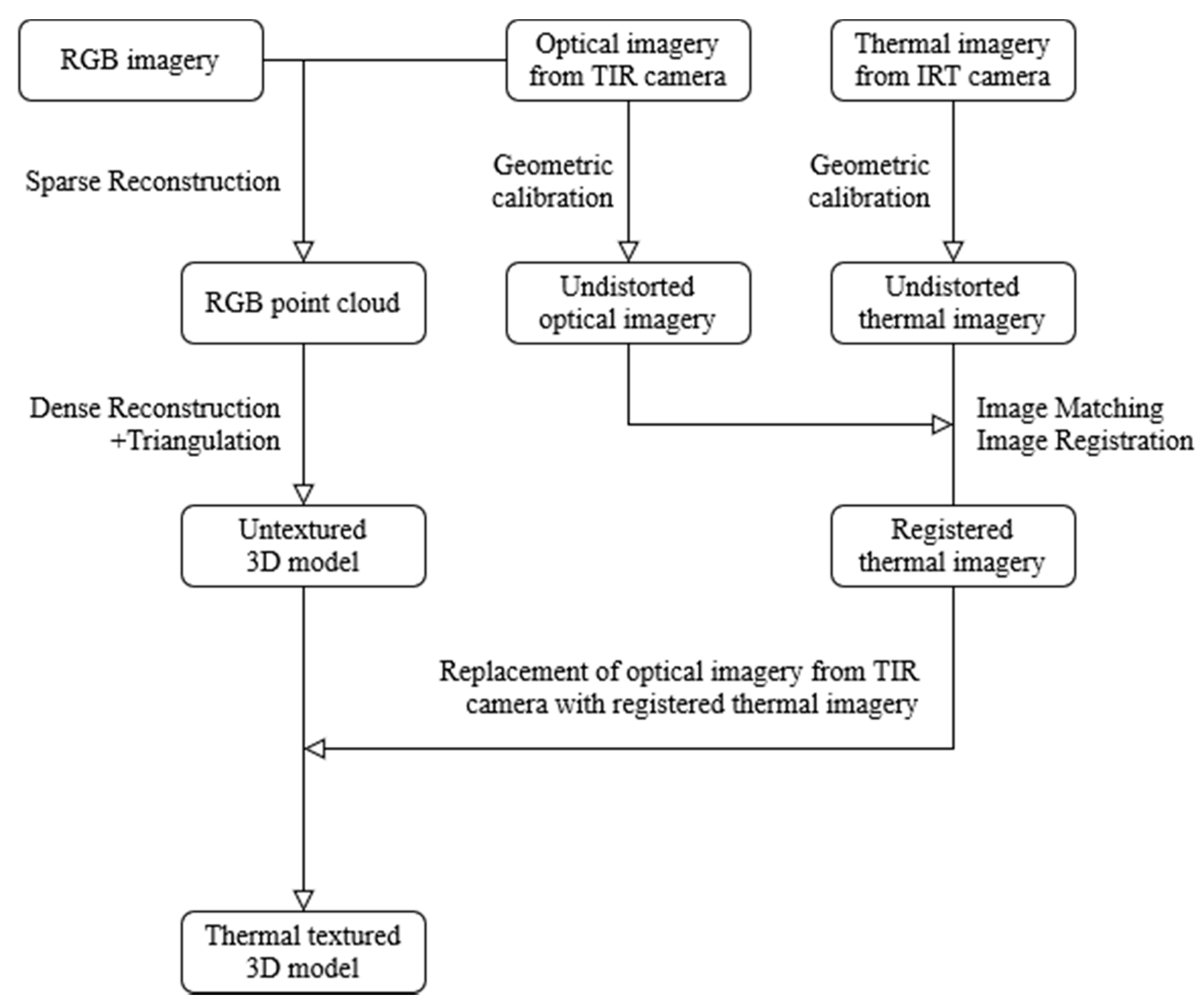
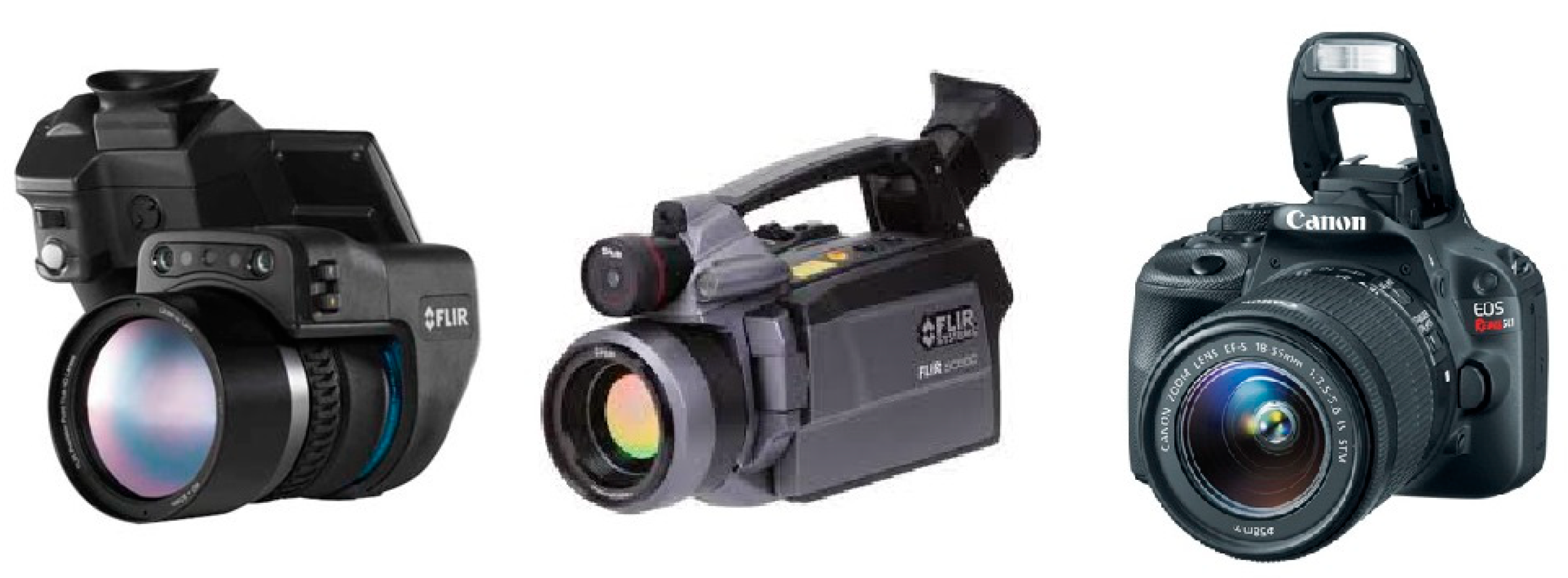
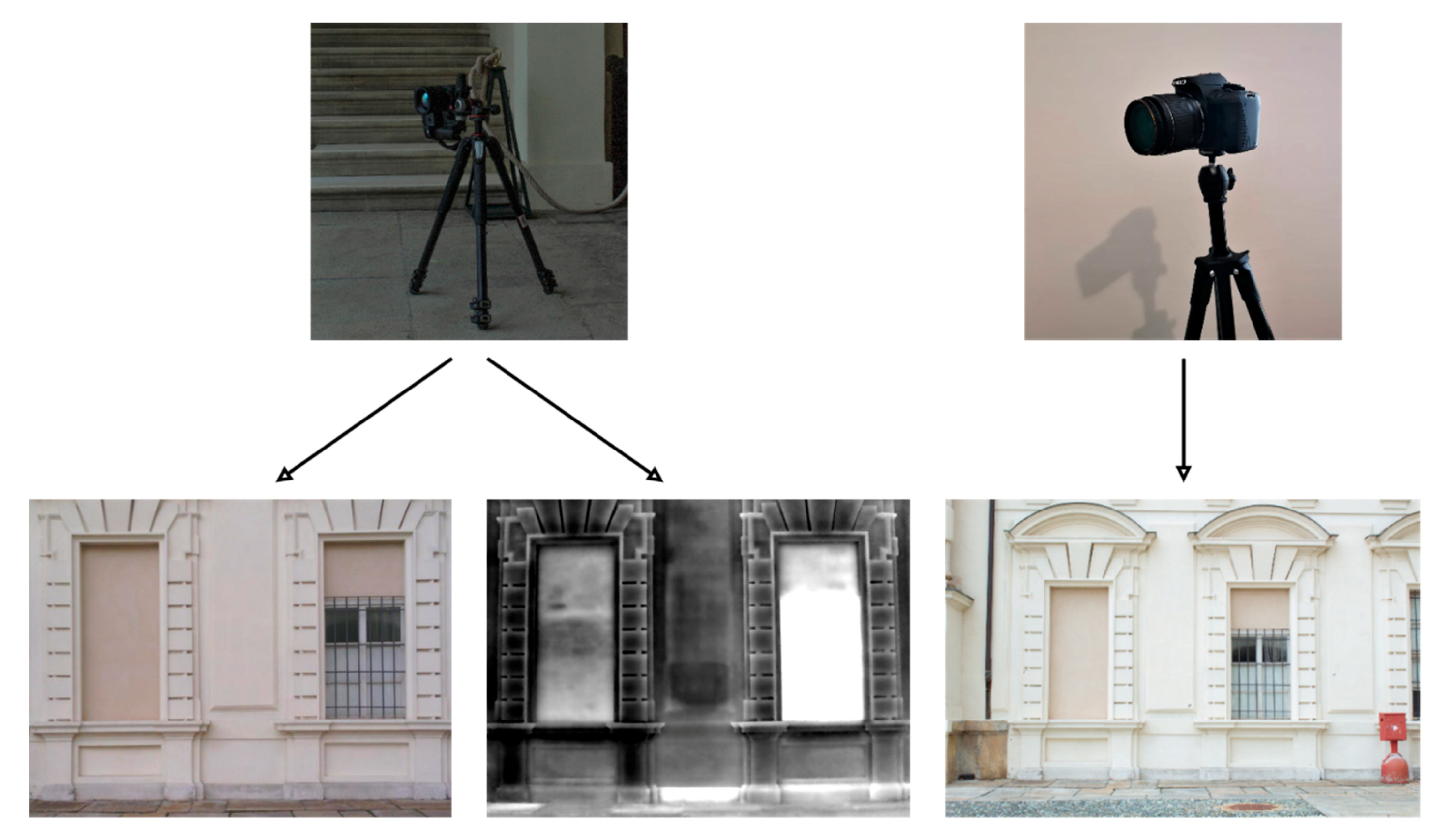
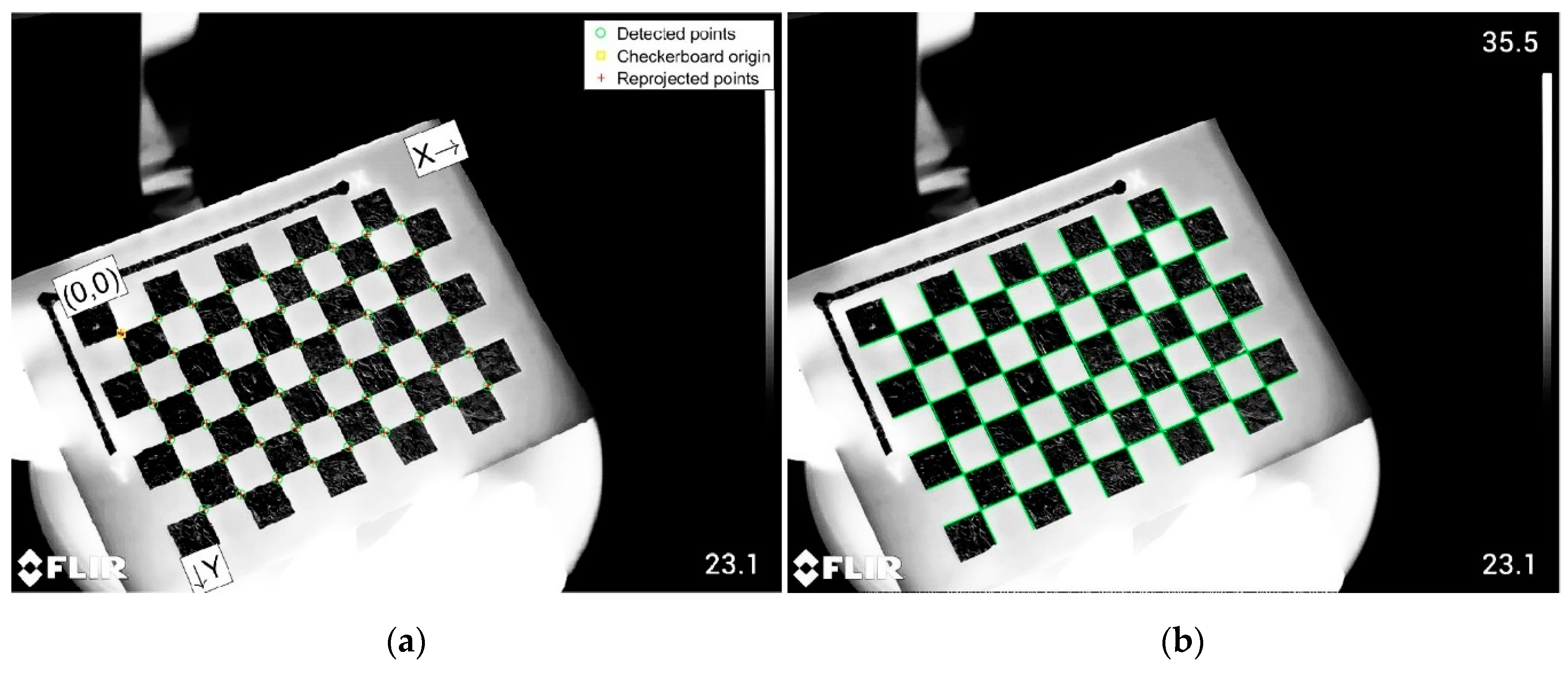


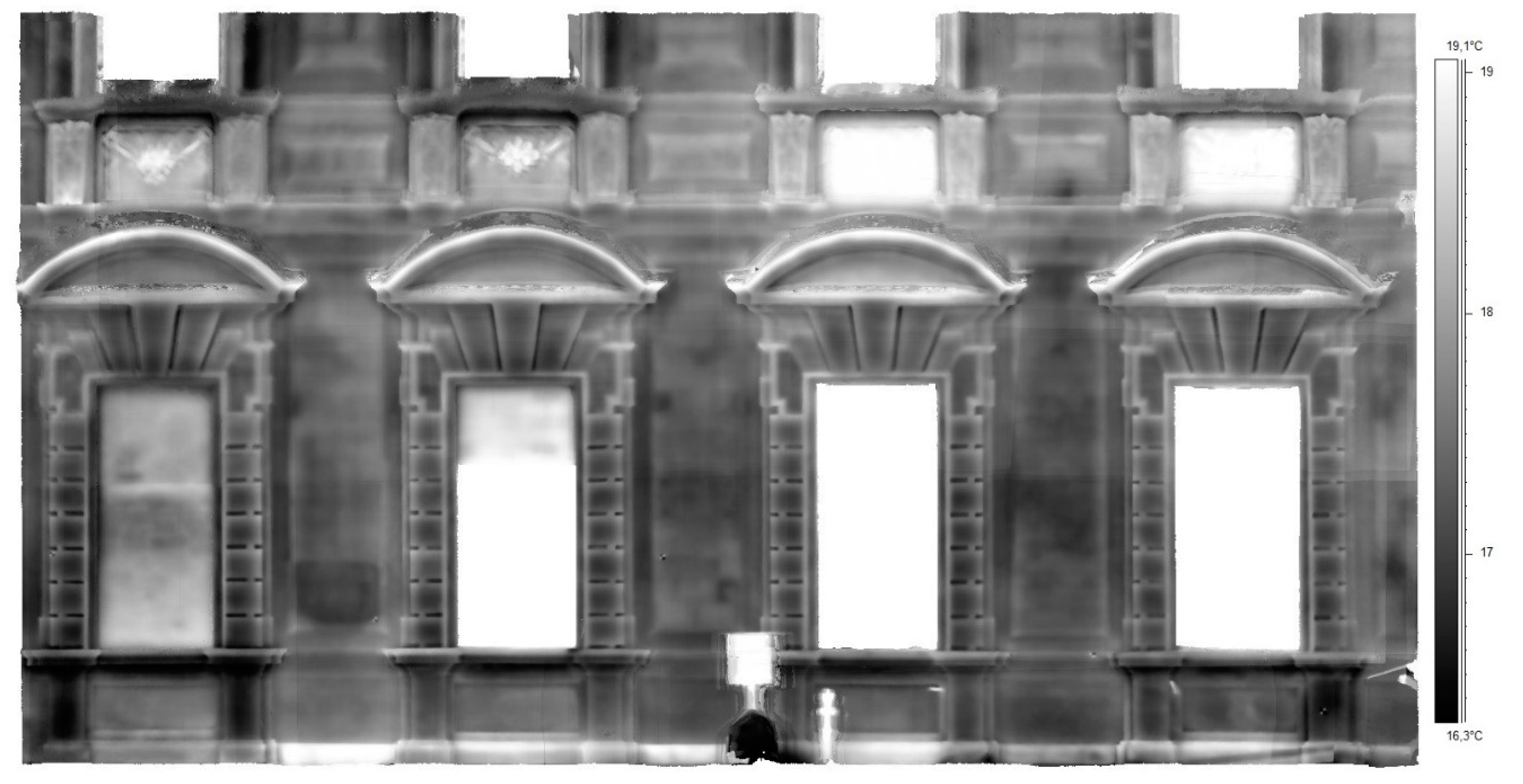
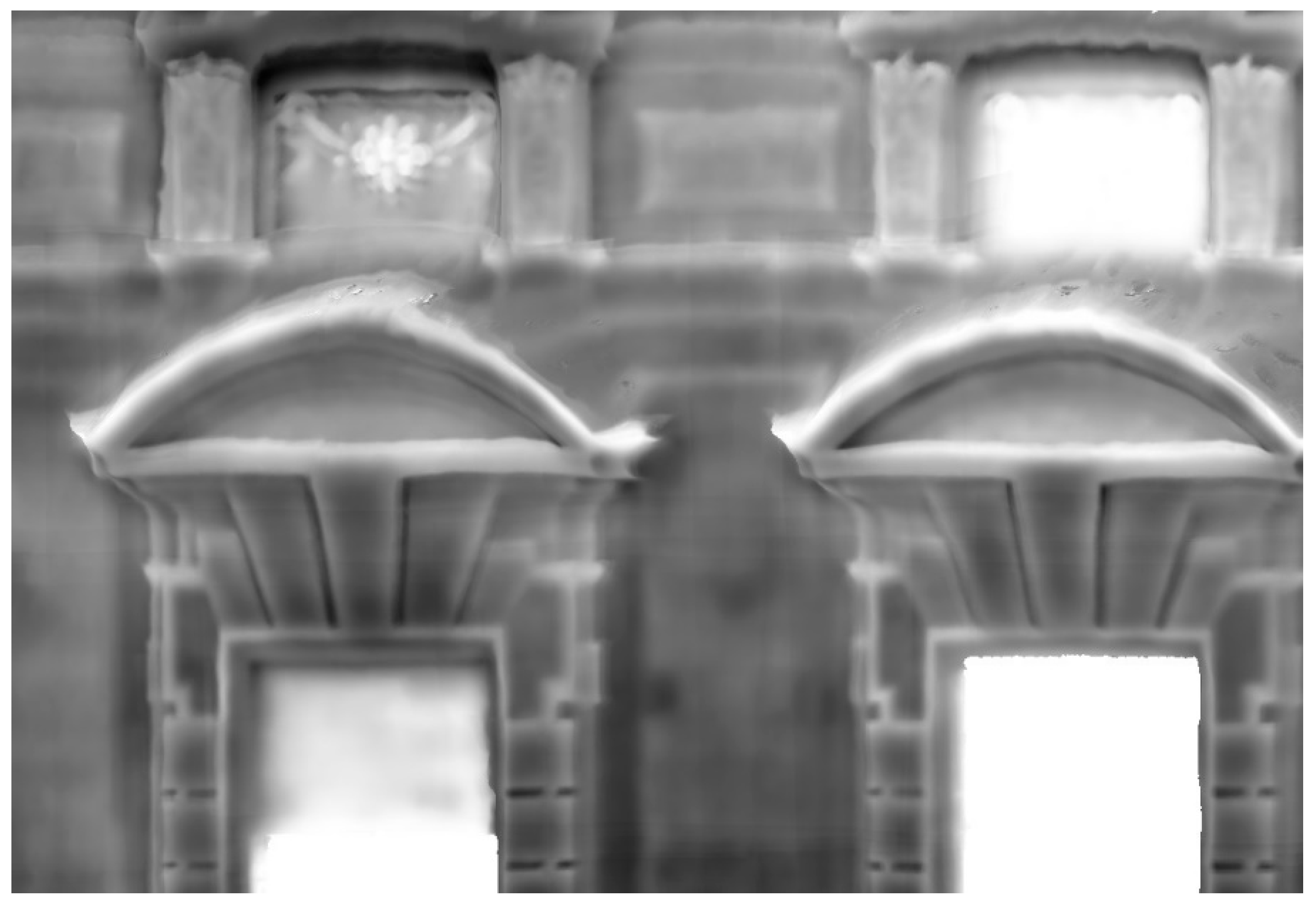



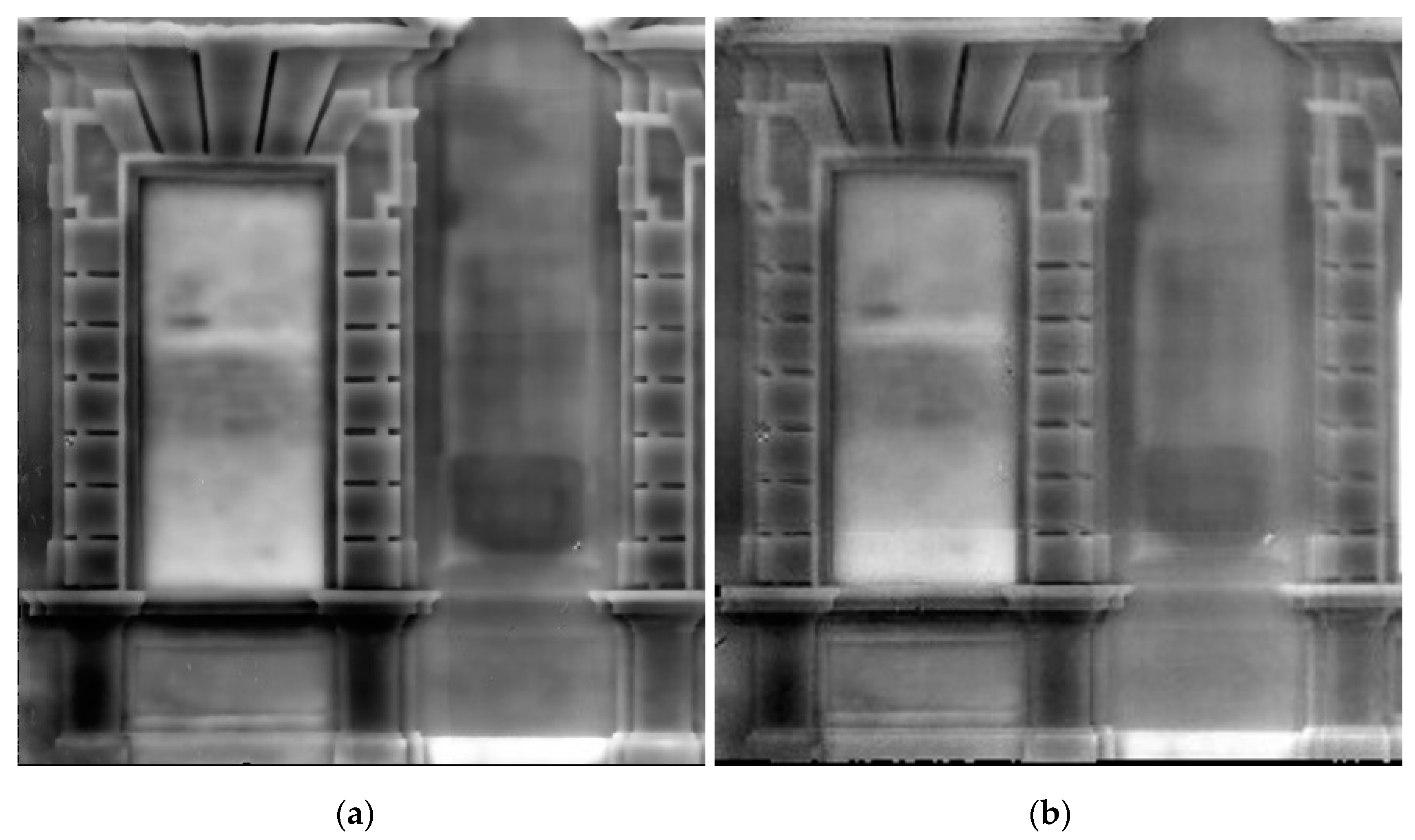
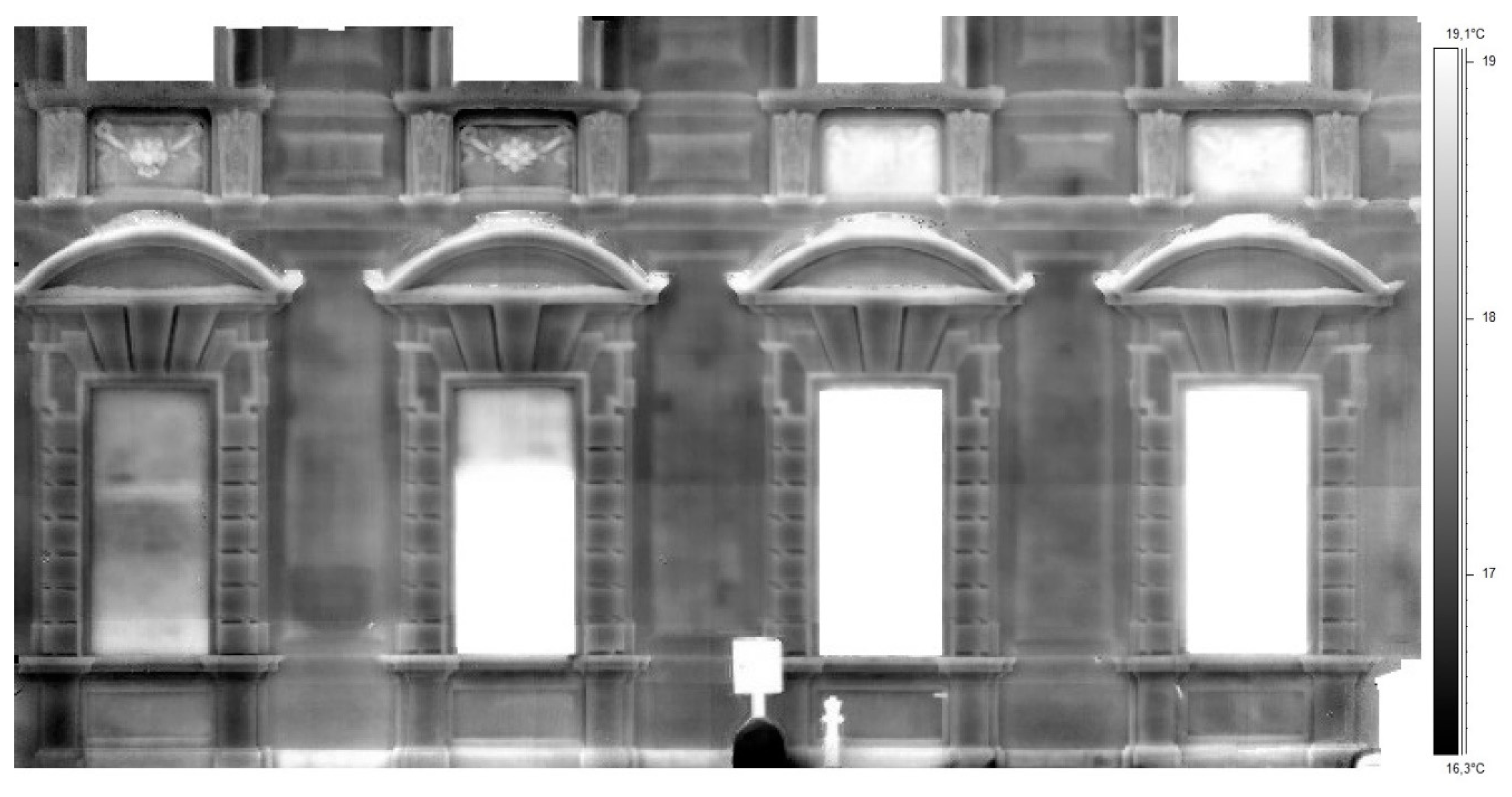
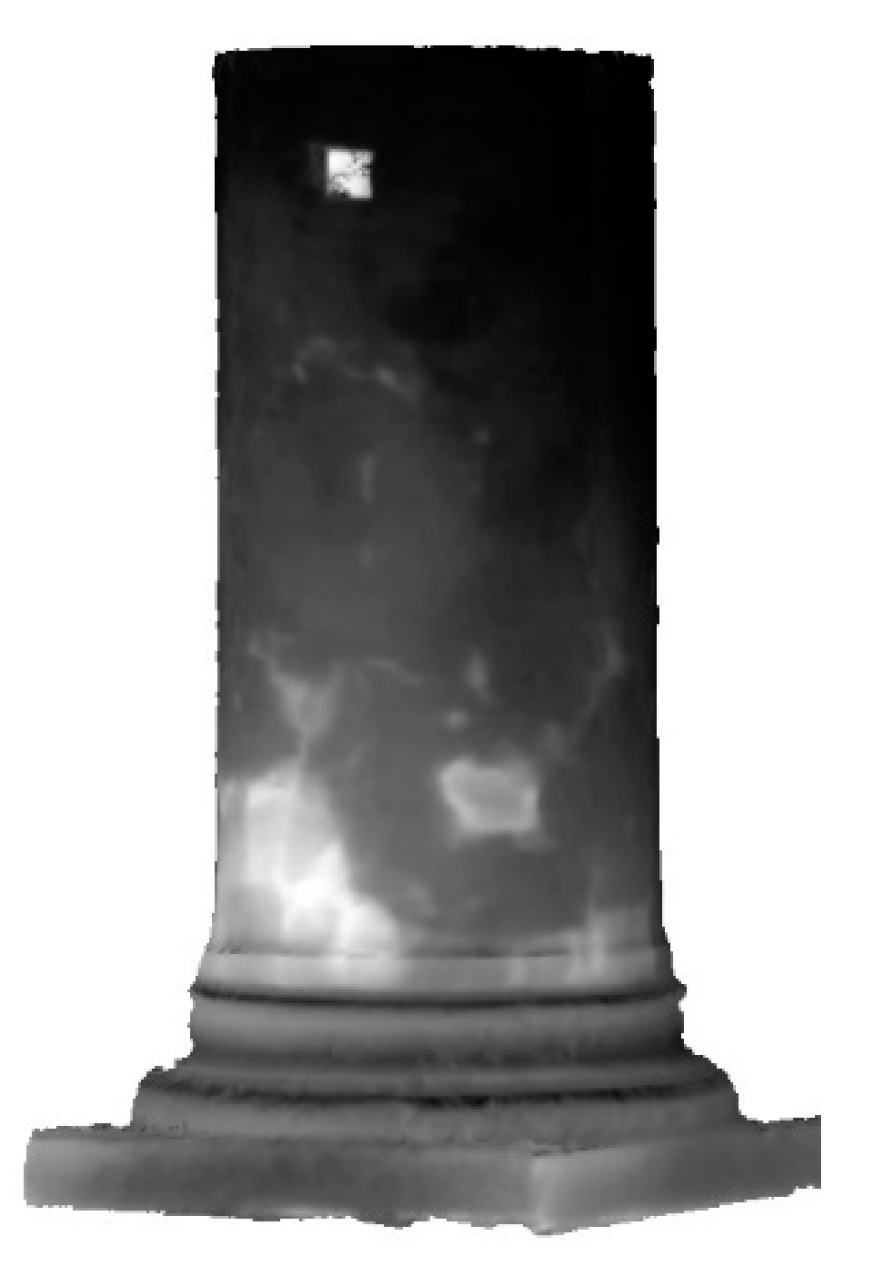
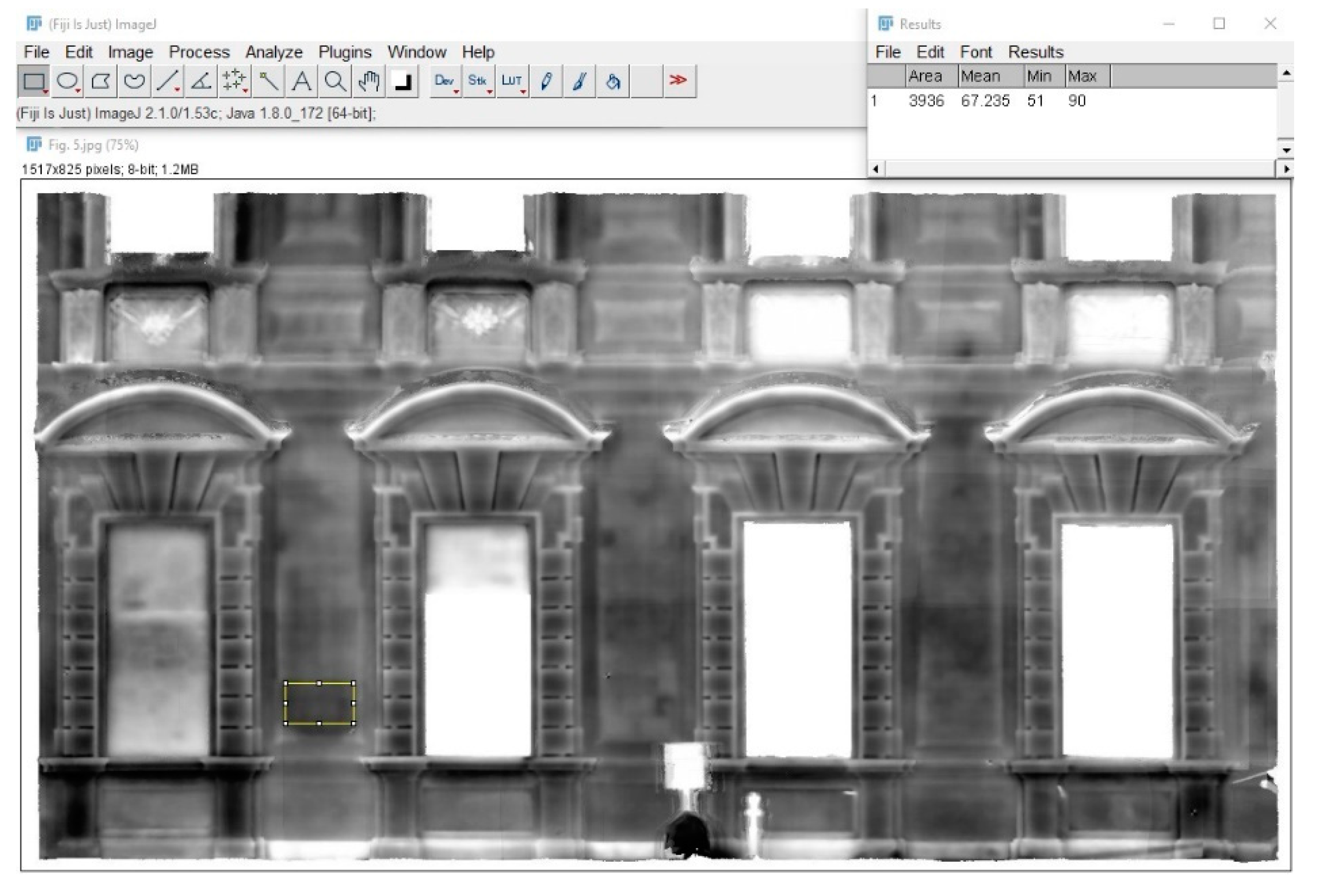
| Imagery Dataset | RMSE *-Control Points (cm) | RMSE *-Check Points (cm) | Point Cloud Density (Millions of Points) |
|---|---|---|---|
| thermal images-FLIR T1030sc | 1.0 | 1.8 | 1 |
| optical images-FLIR T1030sc | 1.8 | 2.8 | 1 |
| optical images-FLIR T1030sc and Canon Rebel-SL1 | 0.9 | 0.7 | 11 |
| optical images Canon Rebel-SL1 | 0.4 | 0.4 | 10 |
Publisher’s Note: MDPI stays neutral with regard to jurisdictional claims in published maps and institutional affiliations. |
© 2020 by the authors. Licensee MDPI, Basel, Switzerland. This article is an open access article distributed under the terms and conditions of the Creative Commons Attribution (CC BY) license (http://creativecommons.org/licenses/by/4.0/).
Share and Cite
Adamopoulos, E.; Volinia, M.; Girotto, M.; Rinaudo, F. Three-Dimensional Thermal Mapping from IRT Images for Rapid Architectural Heritage NDT. Buildings 2020, 10, 187. https://doi.org/10.3390/buildings10100187
Adamopoulos E, Volinia M, Girotto M, Rinaudo F. Three-Dimensional Thermal Mapping from IRT Images for Rapid Architectural Heritage NDT. Buildings. 2020; 10(10):187. https://doi.org/10.3390/buildings10100187
Chicago/Turabian StyleAdamopoulos, Efstathios, Monica Volinia, Mario Girotto, and Fulvio Rinaudo. 2020. "Three-Dimensional Thermal Mapping from IRT Images for Rapid Architectural Heritage NDT" Buildings 10, no. 10: 187. https://doi.org/10.3390/buildings10100187
APA StyleAdamopoulos, E., Volinia, M., Girotto, M., & Rinaudo, F. (2020). Three-Dimensional Thermal Mapping from IRT Images for Rapid Architectural Heritage NDT. Buildings, 10(10), 187. https://doi.org/10.3390/buildings10100187






